A sketchbook welcome page can be wild or chill, but wow—it really sets the vibe! Try hand-lettered greetings with fancy swirls, or go all-in with grungy textures, bold color panels, or even a messy splash of watercolor for instant energy. Minimalist monochrome, doodle frames, and song lyric notes keep things cool, while botanical borders or vintage stamps add style points. With options like these, there’s a totally creative idea waiting for everyone—find out what suits you next!
Key Takeaways
- Hand-lettered greetings paired with inspiring quotes instantly set a positive, creative tone for any sketchbook welcome page.
- Minimalist monochrome motifs or bold block color panels offer sleek, modern aesthetics while keeping the focus on creativity.
- Mixed media accents like washi tape, watercolor splashes, and stickers add texture and vibrancy to your introduction spread.
- Thematic borders such as botanical line art or seasonal floral arrangements personalize your sketchbook with elegant visual themes.
- Unique personalization, like illustrated “About Me” spreads or whimsical doodle frames, showcases individuality right from the first page.
Hand-Lettered Greetings With Flourish
A splash of hand-lettered greetings with a bit of flourish can turn any sketchbook’s welcome page into a real showstopper. Imagine opening your book to see your name swirled in fancy script, maybe with dramatic curls or bold block letters. It’s like rolling out the red carpet—just for your imagination!
Adding little decorative touches, like swirls and doodled stars, makes the page pop and gives a hint of your unique style. Some artists kick it up a notch with color bursts, shadow effects, or soft gradients, making the words leap off the page.
Pairing your hand-lettered greetings with an inspiring quote or motto brings instant inspiration, reminding you why you create. It tells your story before the first sketch appears—how cool is that?
Minimalist Monochrome Motifs
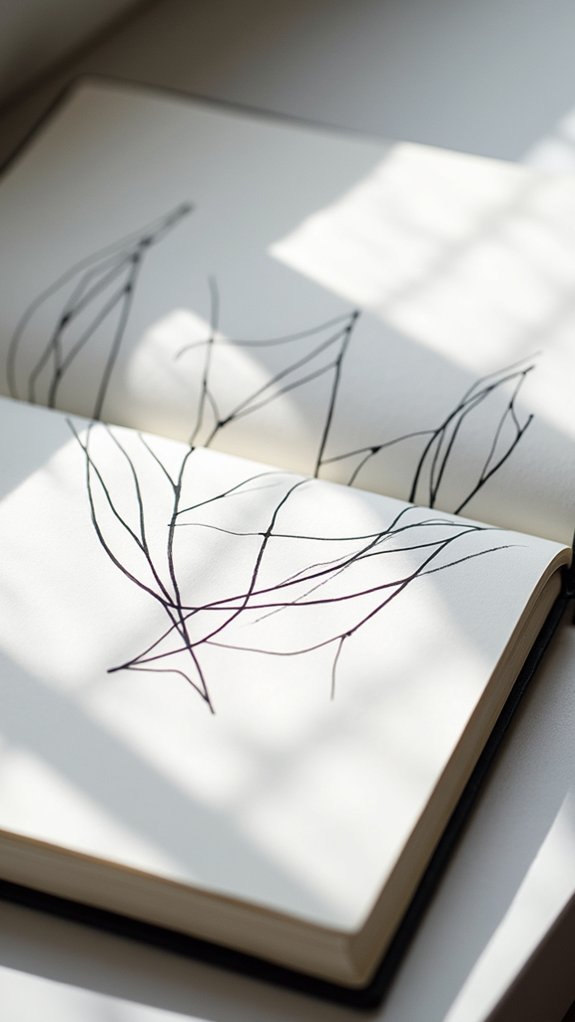
After all that flash and flourish, there’s something seriously cool about stripping things back to basics.
Minimalist monochrome motifs on the first page of a sketchbook can feel fresh—like opening a window in your head before a storm of creativity hits.
Think black, white, and maybe some shades in between; no wild colors to steal the show, just pure style that gets straight to the point.
Here’s what makes this approach so appealing:
- Geometric shapes or sleek line art keep everything clear and uncluttered.
- A limited color palette (just black and white!) brings instant calm and focus.
- Simple typography can add personality without taking over.
- Textures like subtle dots or gradients add just enough flair to stay interesting.
The result? Instant sophistication, zero drama.
Inspirational Quote Collage
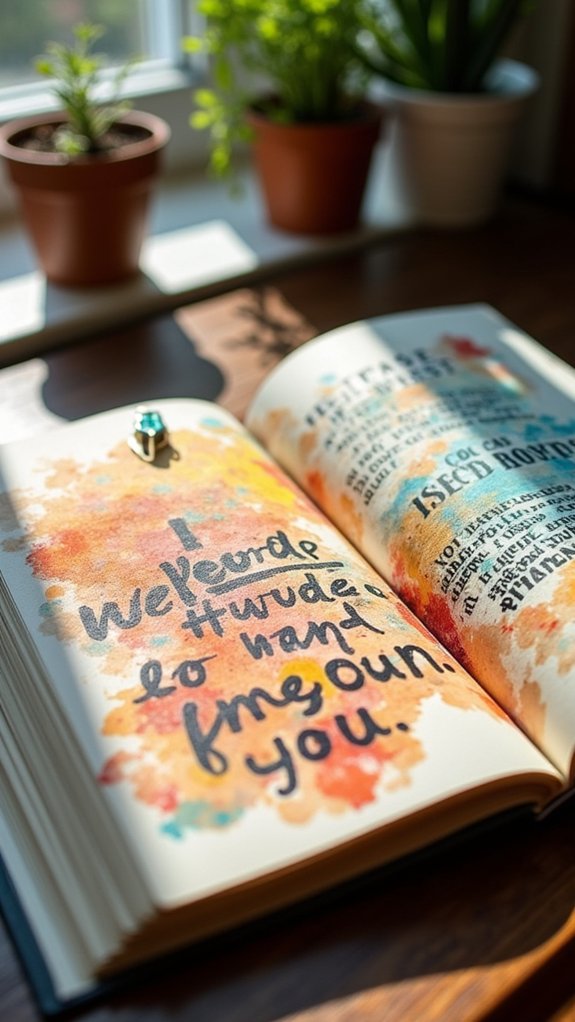
Making an inspirational quote collage means picking out words that actually spark something inside you—plus, it gives you a reason to use all those cool fonts and bright colors you love.
For extra flair, there are all sorts of creative ways to layer magazine snippets, scrapbook paper, or your own doodles to make the quotes really pop.
The mix of personal words and crafty techniques sets an energetic mood right from the first page, kind of like your sketchbook is already cheering you on.
Selecting Meaningful Quotes
Imagine opening a sketchbook and seeing a bunch of bold, colorful quotes bursting across the page—it’s like getting a pep talk from your favorite artists and thinkers every time you start to draw.
Selecting meaningful quotes for a sketchbook welcome page instantly sets the mood, making creativity feel both exciting and possible. Inspiration can come from legendary artists, time-tested philosophers, or even a wacky friend who says cool stuff.
The right quotes are like secret codes reminding you why you make art in the first place. Want your sketchbook to really shine? Try this:
- Pick quotes that reflect your dreams or personal style
- Spotlight your favorite artists’ or writers’ words
- Choose phrases that encourage growth and creativity
- Mix up the quotes as your inspiration evolves over time
Creative Collage Techniques
Sometimes all it takes is a splash of creativity to turn an ordinary sketchbook welcome page into something seriously awesome. Creative collage techniques can take your favorite inspirational quotes and make them pop right off the page.
Imagine mixing magazine cutouts, funky patterns, and little scraps of colored paper—all coming together like they were meant to be BFFs. You can layer a handwritten quote over a burst of color or a cool photo, and suddenly your sketchbook feels like a portal to inspiration city.
Try experimenting with where you stick your quotes—horizontal, diagonal, or even upside down (if you’re feeling wild). Keep a theme or color palette to tie it all together.
And don’t forget to sprinkle in a personal sketch or doodle for extra sparkle!
Bold Block Color Panels
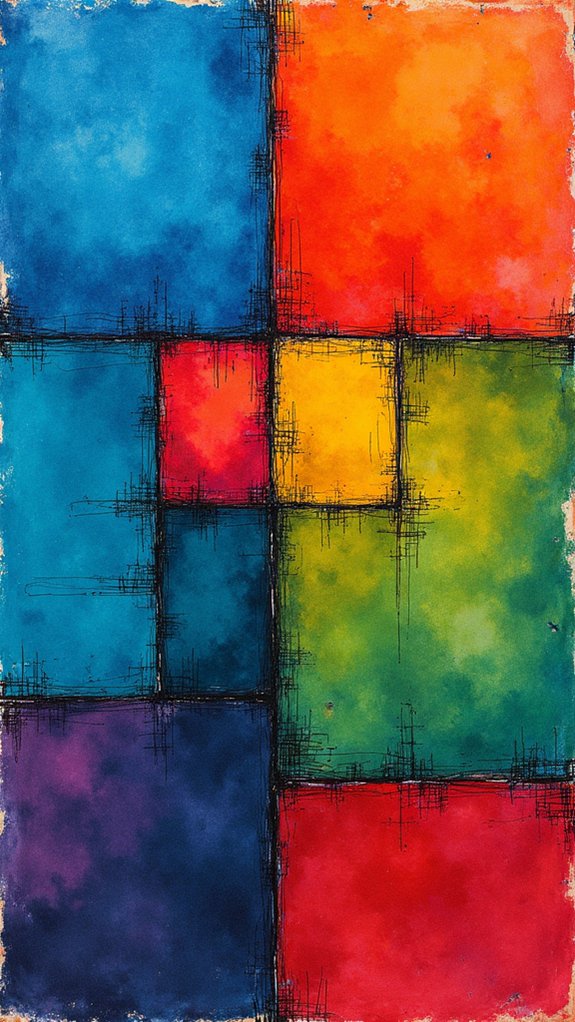
Bold block color panels are all about picking vibrant color combos that practically leap off the page and say, “Hey, look at me!”
It’s a bit like setting the stage—balancing bursts of color with patches of blank space helps the design breathe and keeps things from turning into a neon stampede.
With clever use of highlights, artists can make certain shapes or words pop as the stars of the welcome page, while the rest of the colors cheer them on from the sidelines.
Choosing Vibrant Color Combinations
How does a page jump out and shout, “Welcome!” without saying a word? It’s all about using vibrant color combinations, especially with bold color panels.
The first page of a sketchbook should practically do cartwheels for your eyes, right? Mixing bright, attention-grabbing colors makes everything feel energetic and ready for creativity.
Don’t just toss on every color you know—work smarter with contrasts and clever placement. To make your welcome page really pop, try these ideas:
- Choose two to four bold, punchy colors that vibe well together (think watermelon pink and minty green)
- Experiment with horizontal or vertical stripes for a dynamic, movement-filled look
- Play with textures or opacity in each block for extra depth
- Add contrasting colors for text or doodles to boost visibility and fun
Pick those hues with purpose, and let the page burst with excitement!
Balancing Negative Space
One surefire trick to make a welcome page feel stunning instead of stuffed is to play with negative space—yep, the art of using blank space on purpose.
Imagine dropping in bold color panels, but not letting them take over like a rogue paint spill. By thoughtfully pairing those vibrant panels with empty space, you keep everything crisp, fresh, and far from messy.
The contrast between the bold color panels and the negative space adds loads of visual interest, giving your eyes a break so they don’t get lost in a color avalanche.
Want to up the wow factor? Try using a couple of complementary colors and vary the size or shape of each panel. Suddenly, your design feels lively—like a celebration, not a cluttered party.
Highlighting Focal Elements
After finding that sweet spot with negative space, it’s time to amp up the energy with something that practically shouts, “Look at me!”
Focal elements, like block color panels, bring instant attention to the areas that matter most. These color panels are basically the spotlight of your sketchbook welcome page—they set up a powerful visual hierarchy that’s impossible to ignore.
Want your title or theme to really pop? Try using bold, contrasting panels and toss in some fun geometric shapes for good measure. If you’re feeling adventurous, sneak in a pattern or a cool texture for depth and personality.
Arrange your text and drawings inside these panels, and you’ll guide every viewer’s eye like magic.
- Use color panels for major attention.
- Try wild color combos.
- Add geometric shapes for energy.
- Experiment with patterns and textures.
Illustrated “About Me” Spread
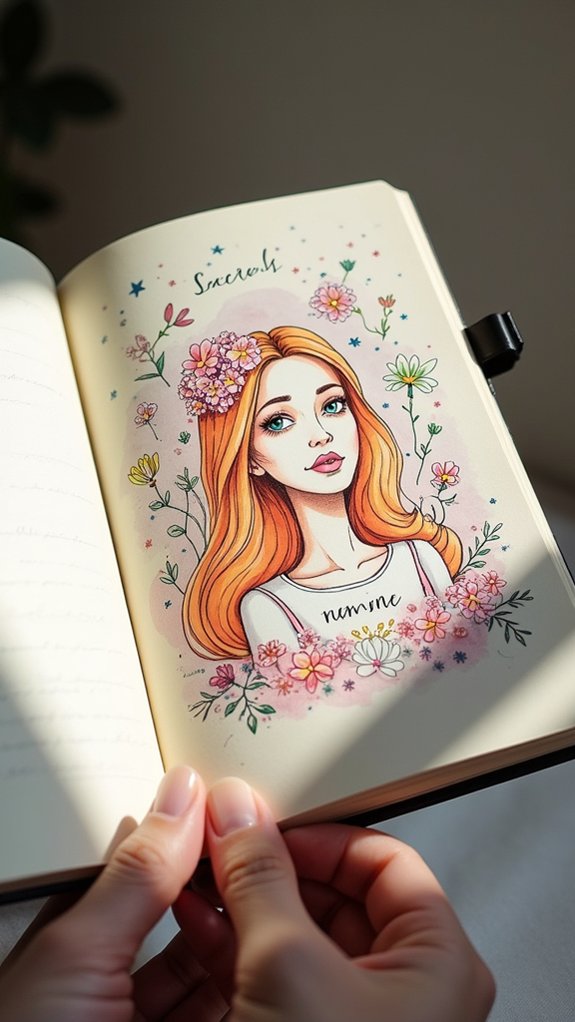
Even before a single masterpiece fills the pages, an illustrated “About Me” spread is like rolling out the welcome mat to a sketchbook adventure.
This creative intro offers inspiration for Sketchbook fans, blending personal storytelling with artistic flair. Imagine your name dancing in hand lettering, surrounded by doodles of your favorite snacks, sports, or pets.
Maybe you add a mini self-portrait with your wildest hairstyle yet, just for laughs. Throw in your favorite color swatches, symbols of hobbies, or snippets from quotes that light up your creativity.
The best ideas and inspiration spark when you mix collaged images, playful layouts, and your unique style. More than just an intro, this spread becomes your very own canvas for trying out new techniques and sharing what makes you, well, you.
Botanical Line Art Border
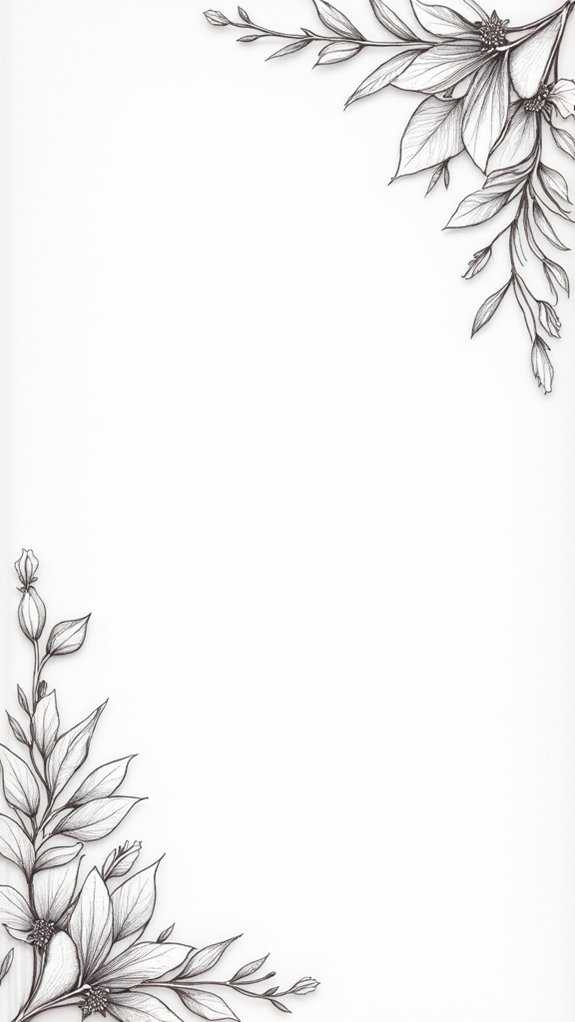
A border bursting with botanical line art is like a big leafy hug for your sketchbook’s welcome page. It’s a clever way to frame your first impression, instantly making the sketchbook feel inviting and a tad magical—like you’re about to wander into a secret garden.
Artists love using fine-liner pens or digital tools to draw those crisp lines and bring plants to life. To keep things lively and not totally predictable, mixing line thickness and playing with styles like stippling adds amazing texture.
The trick is making sure the botanical border doesn’t overshadow the words inside—balance is key. Here’s how to totally nail that botanical border:
- Choose a mix of leaves, flowers, and vines
- Play with thick and thin lines
- Try cross-hatching or stippling
- Keep your welcome message readable
Washi Tape and Mixed Media Accents

Why stick with just pen and ink when there’s a whole world of color and texture begging to jump onto the page? Washi tape brings a burst of personality to any sketchbook welcome page, thanks to its wild designs and the fact that you can rip it off without ruining your paper—pretty handy for perfectionists and experimenters alike.
Using washi tape as borders or section dividers makes your page pop and keeps things organized. But don’t stop there! Mixed media means you can splash on watercolor, layer with ink, or glue in the odd sticker or magazine cut-out.
Suddenly, your welcome page isn’t just an introduction—it’s an explosion of style, creativity, and fun. Plus, add a hand-lettered quote and the book feels 100% yours.
Whimsical Doodle Frame
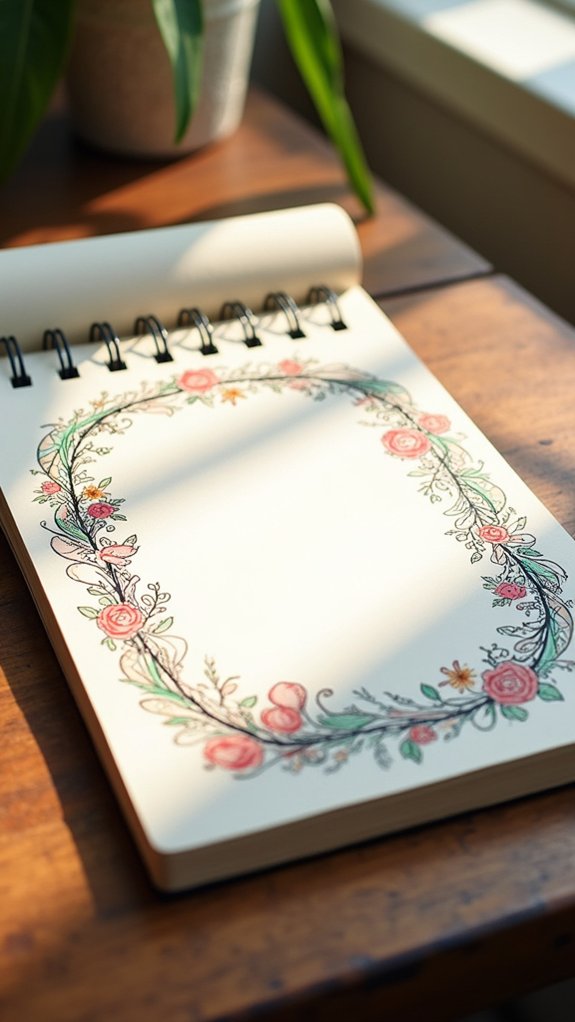
When it comes to sketchbook welcome pages, nothing sets the tone quite like a whimsical doodle frame wrapped around your intro message. Seriously, it’s like inviting joy and creativity right into your sketchbook.
These quirky frames aren’t just window dressing—they’re personality, scrawled right along the edges! Try pulling out all the stops: mix flowers, squiggly stars, and weird shapes with playful colors and bold lines.
Feeling extra creative? Personalize the doodles to show what you love.
- Use thick, thin, and dotted lines, plus swirls and zigzags, for a doodle vibe that pops.
- Try bright or pastel colors, making your sketchbook’s tone joyful or calm.
- Add tiny icons—like musical notes or plants—for your personal stamp.
- Border your welcome message and watch those whimsical doodles welcome you every time!
Vintage Ephemera and Stamps
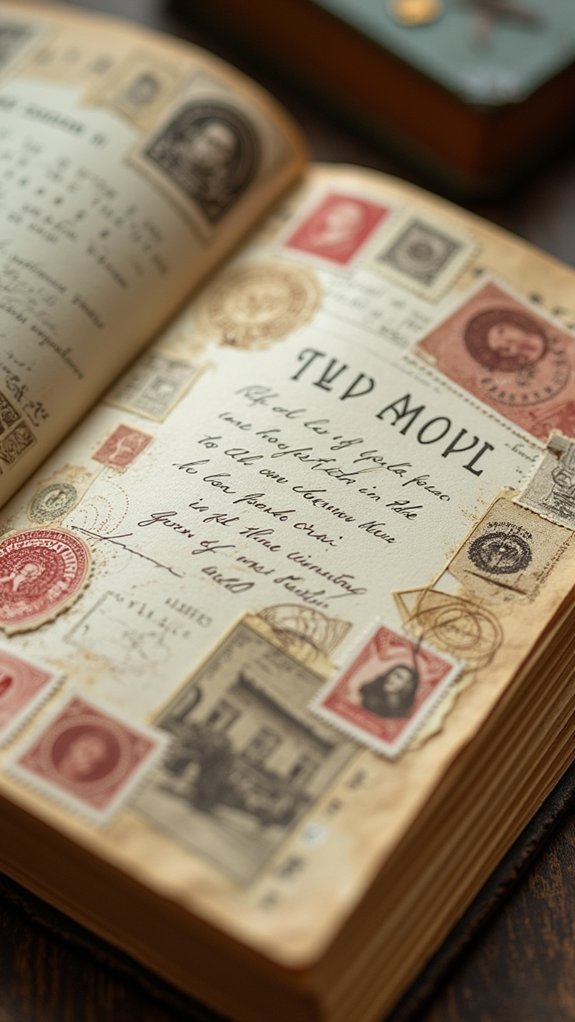
There’s something magical about collaged postage stamp art, where tiny bursts of color and history come together in the most unexpected ways.
Mixing in some antique paper layering and nostalgic stationery accents can turn a plain welcome page into a treasure map of stories—like a secret handshake for vintage fans.
Who knew that ticket stubs and old envelopes could basically time-travel right into your sketchbook?
Collaged Postage Stamp Art
A handful of old postage stamps, mixed with bits of vintage ephemera, can turn any plain sketchbook welcome page into something seriously cool and totally unique.
Collaged postage stamp art brings a dash of nostalgia and adventure to your new sketchbook, letting you travel the world without leaving your desk. Stamps from different countries spark curiosity, and when you add random pieces of old paper or hand-scribbled quotes, the page comes alive with stories you get to invent.
For anyone who thinks a sketch book should start with a burst of imagination, here’s how to make it really pop:
- Mix colorful stamps with handwritten notes for personality
- Try different shapes and sizes for a snazzy layout
- Use archival glue to keep everything safe
- Layer stamps with cool ephemera for extra dimension
Antique Paper Layering
Stacks of old letters, scraps of yellowed book pages, and a sprinkle of vintage postcards—few things feel more treasure-hunt-worthy for a sketchbook welcome page than antique paper layering.
It’s like making a cozy nest for your art, using bits of vintage ephemera that hold secret stories. Old stamps become time travelers, each one unique, adding little pops of color and history to your masterpiece.
Layering techniques are what make this look incredible: overlap edges, tuck corners, and play with textures to build real depth. For extra magic, use sepia ink or faded pens—it ties the whole page together and makes it feel like something you just discovered in an attic.
Nostalgic Stationery Accents
Postcards with curling edges, faded ticket stubs, and stamps from a time when people actually sent letters—these are the rockstars of a truly welcoming sketchbook page.
Adding vintage ephemera brings a wave of nostalgia, creating a welcome page that feels like grandma’s attic: full of stories and little treasures. Mixing and matching these finds with a collage of memories gives the page texture and depth, almost begging you to touch every layer.
Muted color palettes—think faded blues, mellow browns, gentle yellows—set a chill, inviting vibe. For sketchbook creators, sourcing these accents isn’t about finding the rarest stamp ever, but about building your own vibe.
Here are some cool ways to use them:
- Create tiny envelope pockets
- Decorate with torn map scraps
- Layer vintage stamps for borders
- Mix modern sketches with old ephemera
Watercolor Splash Background
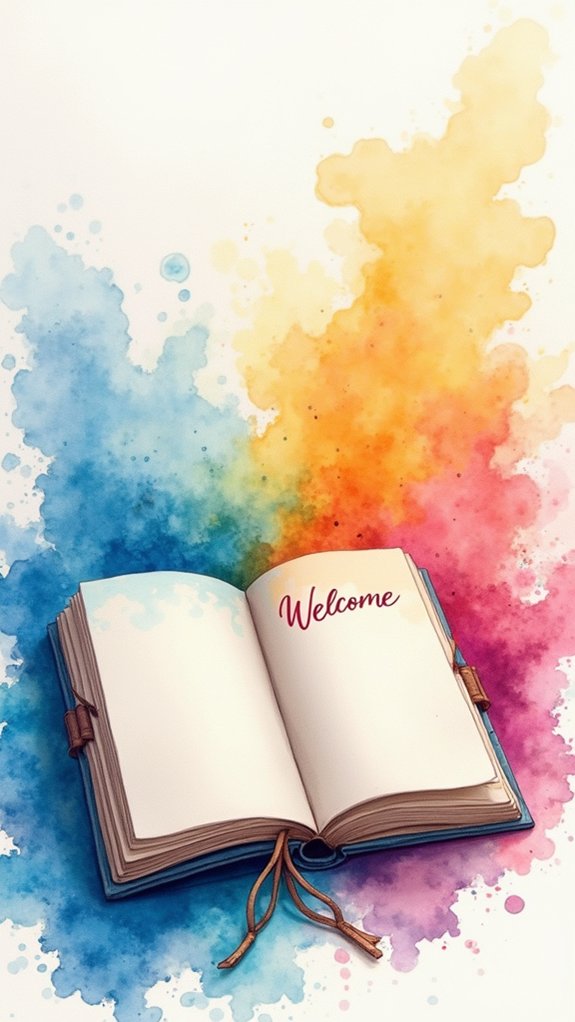
Watercolor splash backgrounds have a way of making any sketchbook welcome page feel like the start of some grand adventure—kind of like jumping into a puddle and watching colors swirl everywhere.
There’s something magical about seeing bright blues, pinks, or even wild greens drift and blend together, setting the mood for creativity before the first sketch.
Watercolor splash effects are pretty easy to make, even if your only art experience involves messy hands and the occasional runaway brush.
Just get the page wet, toss on some color, and watch organic shapes appear—almost like the paint is doing half the work!
These splashes make a lively backdrop for welcome messages or themes, inviting anyone to let go of perfection and dive right in, no hesitation.
Personal Symbol or Logo Spotlight
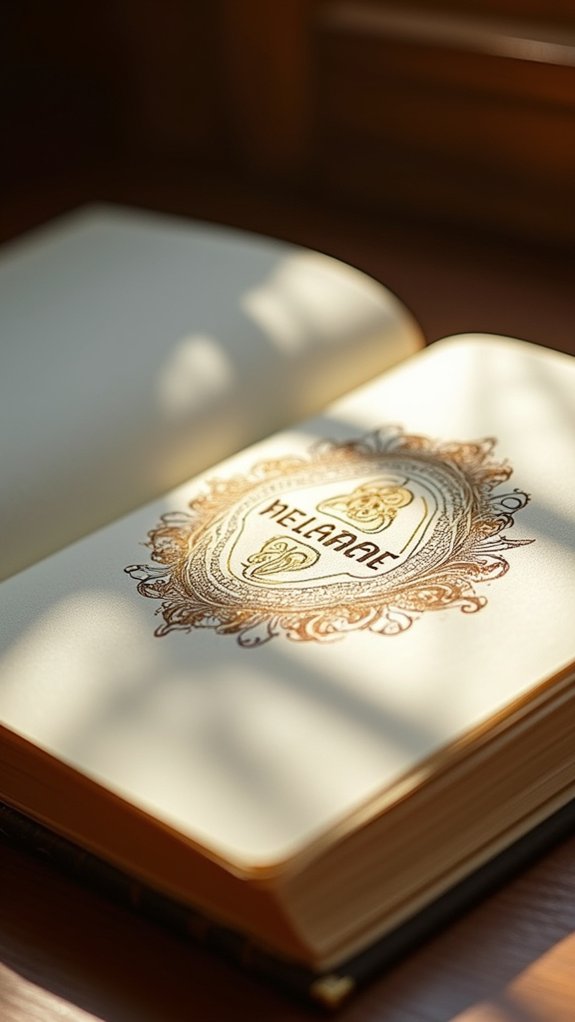
Now comes the fun part—creating a signature motif or personal logo to feature on your welcome page.
Should it be small and mysterious, tucked in the corner, or bold and proud, right in the center?
Placement and size can totally change the vibe, so it’s like picking whether your logo wants to shout or whisper, and really, both options have their own cool magic.
Designing a Signature Motif
A sketchbook isn’t just a bunch of empty pages; it’s like a front door into an artist’s imagination, and nothing says “This is my house!” like a signature motif.
Designing a signature motif—basically, your own personal logo—helps create a cohesive visual theme for your entire sketchbook. It’s a small design with a big job: letting people know this book belongs to you!
Think about what makes your art special, then try weaving it into a one-of-a-kind symbol.
Need some ideas? Here are a few simple sparks to get you started:
- Doodle your favorite animal, plant, or magical symbol.
- Combine your initials in a creative way.
- Sketch a quirky object you draw all the time.
- Use shapes or lines that reflect your style.
Instant ownership, infinite creativity!
Logo Placement and Sizing
Even before the first page gets filled with wild doodles and creative chaos, the placement and size of a personal logo or symbol can set the whole vibe for a sketchbook’s welcome page.
Where that logo lands—top, center, maybe hugging the left margin—acts as your own secret handshake, telling everyone who cracks open your book whose world they’re entering.
Logo placement is like picking the coolest seat at the lunch table: it matters! If the logo sizing is just right, about 10-20% of the page, it won’t look squished or like it’s shouting for attention.
Use bright colors, bold lines, even a snazzy border to help your artistic identity pop. Play around until it feels perfectly you—this is your creative territory.
Dreamy Gradient Wash Welcome
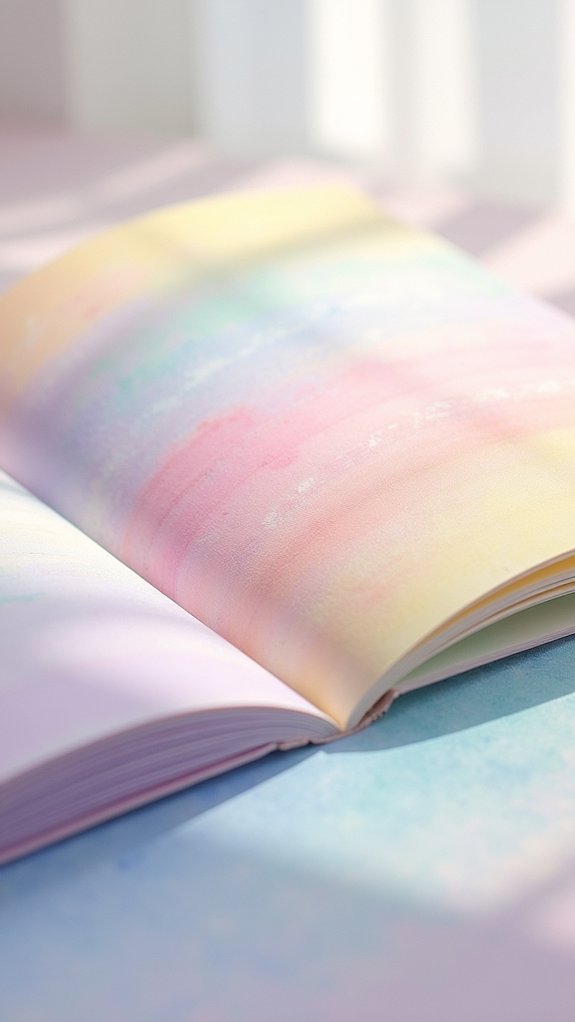
Magic happens when a sketchbook greets its owner with a dreamy gradient wash welcome page, setting the vibe for creativity right from the first glance.
This soft and magical style uses gentle blends of soft colors, like pastel pinks or sky blues, to make the page feel calm and inviting—kind of like a soothing sunset at the end of a long day.
Starting with a slightly wet page helps colors flow and mix smoothly, creating that perfect dreamy gradient wash that’s impossible to mess up!
To boost the magic, artists often add hand-lettered text for a pop of personality.
- Wet your paper before adding any color to blend smoothly.
- Use soft colors for a gentle, cozy effect.
- Add simple hand-lettered text for style and clear labeling.
- Decorate subtly with small doodles or motifs.
Season-Themed Floral Arrangement
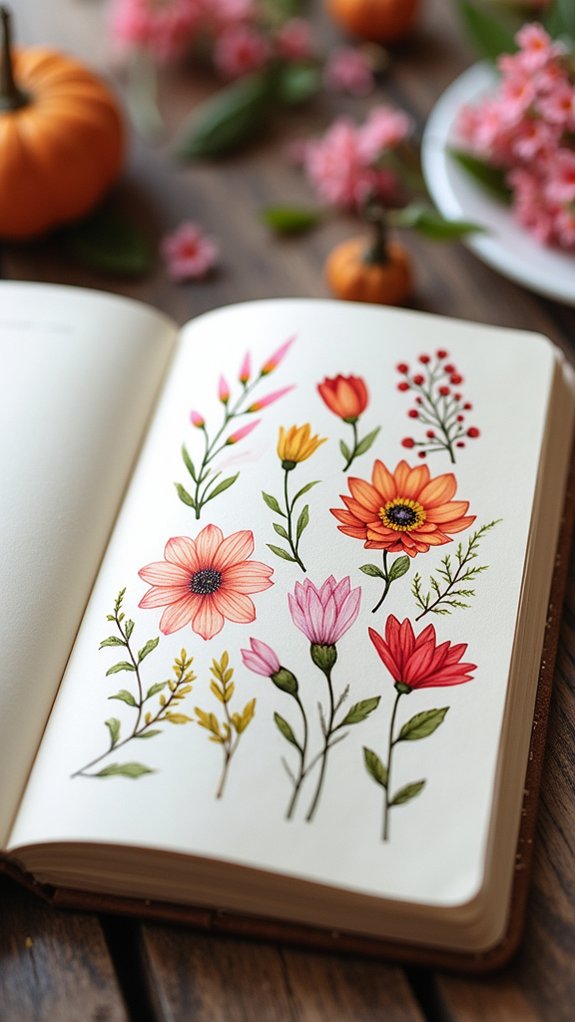
A season-themed floral arrangement starts with picking a spring blooms color palette—think soft pinks, fresh greens, and pops of yellow that make the page feel alive.
It helps to place those tulips and daffodils in little clusters, maybe have some leaves peeking out here and there, or let them twist around the edge for a bit of drama.
Careful placement can turn even basic flowers into something that looks like a celebration right there on the page!
Spring Blooms Color Palette
Excitement sparkles in the air when it’s time to pick out a spring blooms color palette for a sketchbook’s welcome page.
There’s just something magical about choosing soft pastels and cheery colors that shout “spring is here!” Pinks, buttery yellows, and mint greens bring the feel of brand-new life—like those first tulips or daffodils poking through the soil.
Mixing and matching makes the page pop, and sometimes a bit of lavender or a cherry blossom pink gives that wow factor.
Some fun ways to build the perfect palette:
- Pair light pinks with soft greens for a subtle, flowery look.
- Play with buttery yellow and mint green for bright, fresh vibes.
- Use lavender for a dreamy touch.
- Create a mood board with favorite spring blooms!
Seasonal Foliage Placement Tips
Ever wonder how to make a sketchbook page totally pop with seasonal vibes? Here’s a secret: it’s all about arranging your foliage like a pro.
Start by picking native plants—they don’t just look awesome, they help the environment too! Grouping similar colors (think oranges and yellows for fall or blues and whites for winter) creates seasonal arrangements with instant wow-factor.
Height matters, so use tall stems in the back to grab attention and layer shorter pieces up front for extra depth. Don’t forget fun seasonal accents, like pinecones, berries, or even a quirky dried flower for personality.
And the ultimate trick—snip those stems at an angle and ditch any soggy leaves so your arrangement (and your art!) stays fresh and vibrant.
Grunge Texture Layers
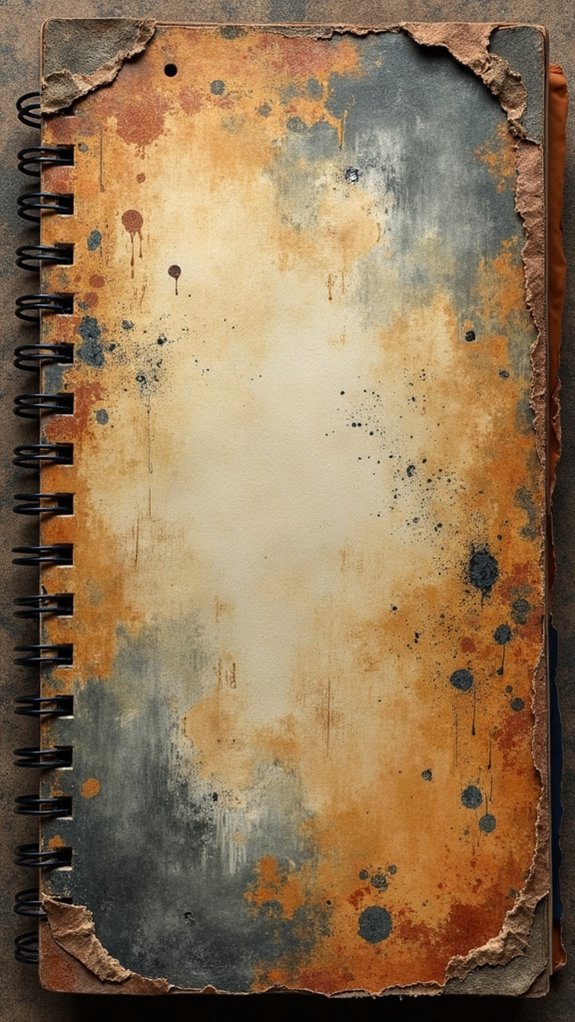
Think of a welcome page as the front door to a sketchbook—now imagine splashing that door with messy splatters, scratches, and rough patches that give it serious character.
Grunge texture layers do exactly that! By working in things like dark colors and gritty surfaces, artists can totally change the mood from clean and cheerful to bold and mysterious.
It’s not just about looks. Grunge textures turn a regular welcome page into a moody, edgy statement piece.
Want to get started? Try these ideas:
- Experiment with mixing paper, fabric, or paint for textured layers.
- Use stains and scratches with dark colors to build up a moody vibe.
- Add cool quotes in a grungy font for an artistic touch.
- Mess around with digital or manual tools for custom textures.
Music-Inspired Notation Elements
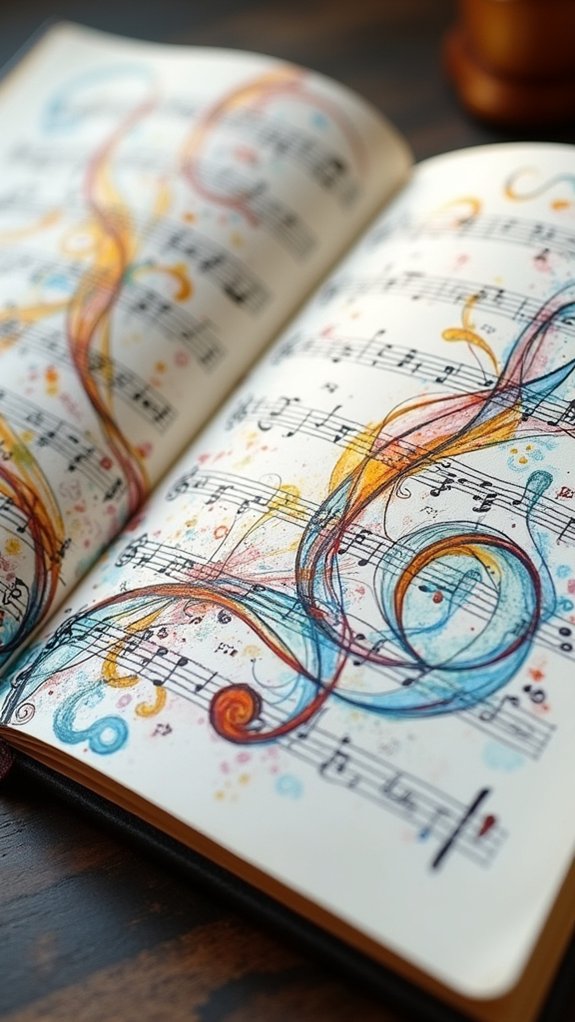
How does a sketchbook’s welcome page go from just “hello” to an all-out jam session? The answer: music-inspired elements that practically sing off the paper!
Imagine opening your sketchbook and seeing treble clefs, bass clefs, and those swirling musical symbols setting the vibe right away. Adding hand-drawn musical notation—staff lines, notes, even whole measures—creates a background that moves with energy.
Want to crank up the meaning? Quote a favorite musician or scribble lyrics that speak your truth—instant connection!
Don’t forget colors; match them to your musical mood. Neon for pop, deep blues for jazz, whatever speaks to you.
Throw in cut-out concert tickets, tiny instrument doodles, or old album covers and suddenly, your sketchbook has its own playlist!
Geometric Pattern Play
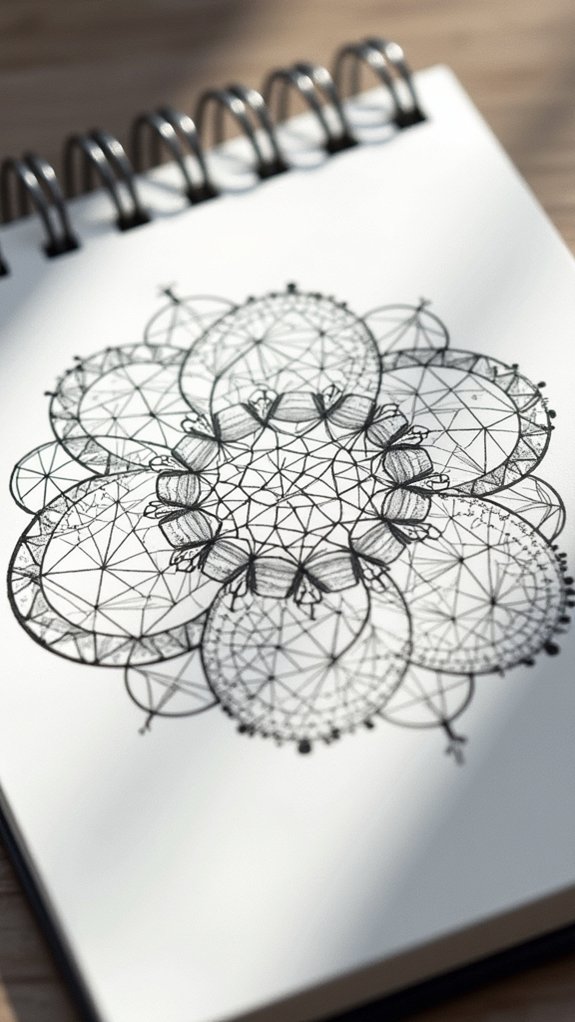
Once the music fades and the last note lands on the page, there’s a whole new way to make a sketchbook welcome page burst with personality—bring on the geometric pattern play!
Geometric patterns are like the cool best friend who knows how to make any page look good, adding buckets of visual appeal while keeping things organized. Think triangles, circles, hexagons, all working together to wow anyone who cracks open your book.
Add some contrasting colors or clever shading tricks, and boom, your welcome page instantly stands out. And don’t forget, you can personalize the look with touches like your initials or a favorite quote.
- Mix shapes like triangles, circles, and hexagons
- Add bold color contrasts or shading
- Keep it accessible—great for all skill levels
- Personalize with initials or quotes
Storyboard Panels of Your Day
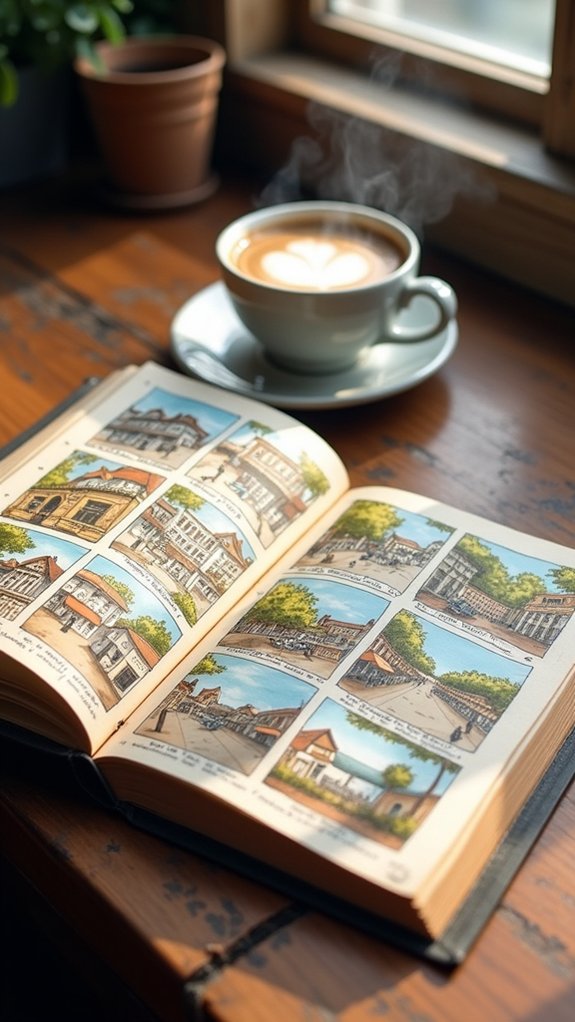
Every sketchbook tells a story, but not all of them lay it out like a comic strip straight from your own life. Storyboard panels are an awesome way to map out your daily experiences, almost like turning your day into a movie storyboard.
Each box on the page becomes a little stage for a special moment, whether it’s spilling milk at breakfast, acing a quiz, or surviving math class. Simple sketches, quick doodles, or funny notes personalize each panel and help you focus on what truly mattered during the day.
It’s low-pressure, creative, and actually helps flex your composition muscles without feeling like homework. Plus, seeing your day lined up in storyboard panels kind of turns you into the hero of your own sketchbook saga.
Calligraphy With Gilded Details
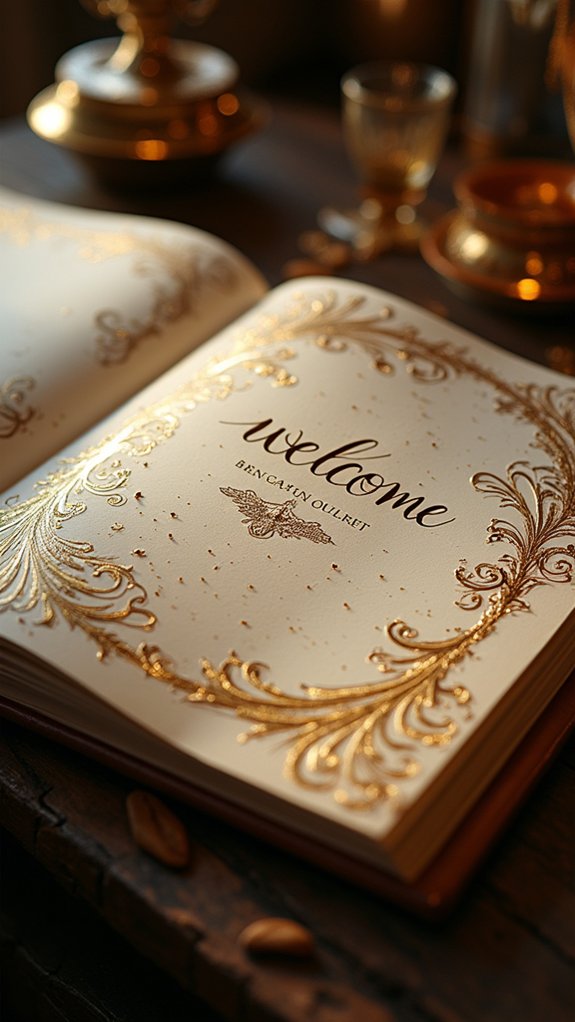
There’s just something magical about seeing calligraphy paired with shiny, gilded details on a sketchbook’s welcome page—it’s like the art version of rolling out a red carpet.
Right away, it gives a first impression that’s both fancy and totally eye-catching. Calligraphy brings an elegant, personal flair, and those gilded details? Instant sparkle. It’s hard not to smile when the light catches a gold flourish!
- Choose different calligraphy styles like copperplate or modern, and pick one that matches your sketchbook’s vibe.
- Use quality calligraphy pens and brushes, plus real gold leaf or metallic paints, for that polished wow-factor.
- Experiment with flourishes and decorative borders around the letters to frame your masterpiece.
- Don’t forget—the gilded details can be tiny accents, not just big statements!
Frequently Asked Questions
What Should I Put on the First Page of My Sketchbook?
When considering what to put on the first page of a sketchbook, one might include personalized quotes, a summary of artistic goals, or illustrations featuring favorite colors, creating a motivating and individualized introduction to their creative journey.
What Should I Draw on My First Page?
When considering what to draw on the first page, one might seek first page inspiration by exploring simple doodle ideas or sketching a meaningful personal mantra. These choices encourage creativity and relieve pressure for a perfect beginning.
How to Decorate a Drawing Book First Page?
When decorating a drawing book’s first page, one might include creative quotes or a personal motto, illustrating artistic goals visually. Decorative borders, meaningful illustrations, or mixed-media elements can help personalize and inspire ongoing creative exploration throughout the book.
What’s the Coolest Thing to Draw?
The current question invites diverse creative possibilities; many consider fantasy creatures, urban environments, or abstract patterns the coolest subjects to draw. Such imagery allows artists to exercise imagination, experiment with techniques, and convey unique interpretations of the world.
Conclusion
A sketchbook’s welcome page is like the red carpet for your art—first impressions really do count. Whether you choose wild doodles, glittery calligraphy, or just a super cool quote, your design sets the mood for everything that follows. Don’t stress about perfection; it’s all about showing your style and having fun. Remember, there are no art police, so take risks, get a little weird, and make that first page totally, undeniably yours.

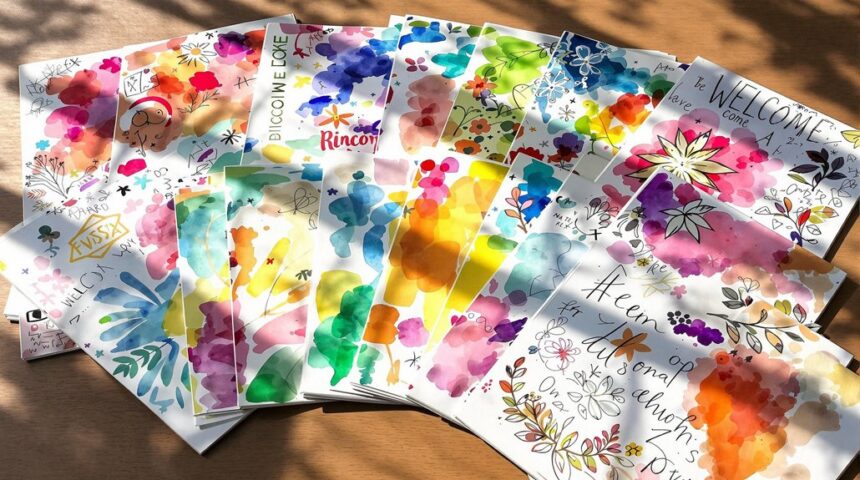
Leave a Reply